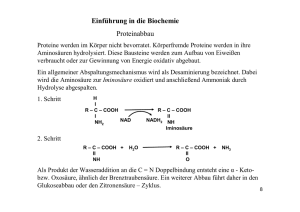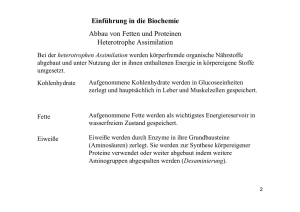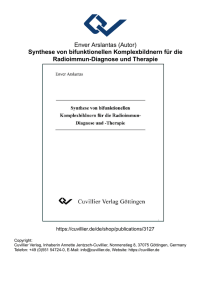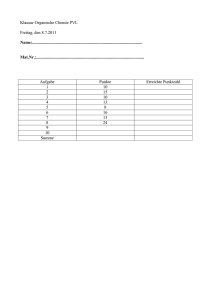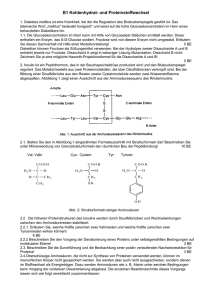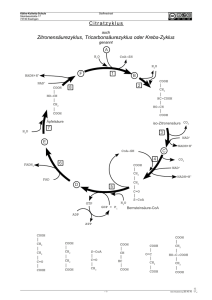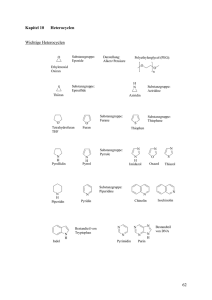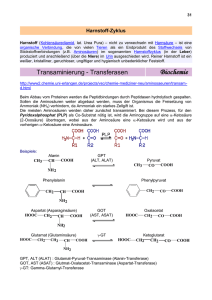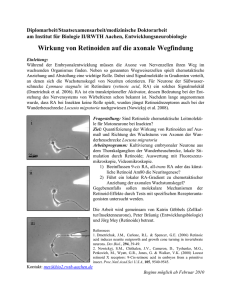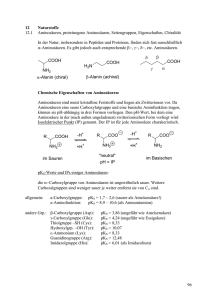Frage der Substrataktivierung in Isocitrat-Lyase - ETH E
Werbung
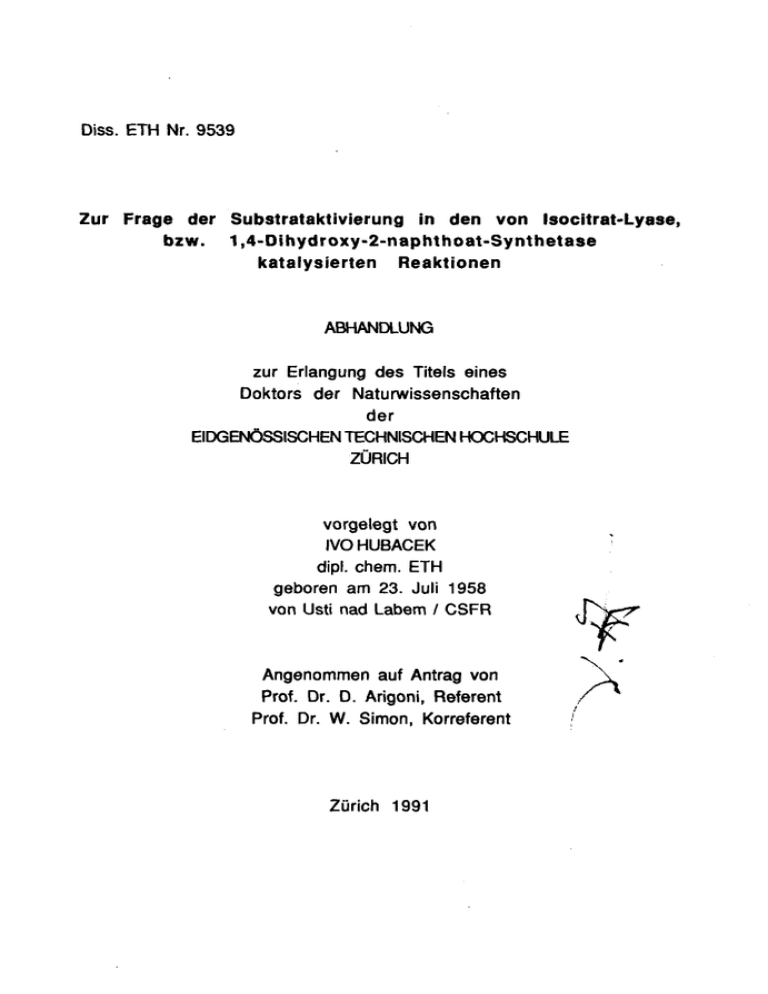
Diss. ETH Nr. 9539 Zur Frage der bzw. Substrataktivierung in den von Isocitrat-Lyase, 1,4-Dihydroxy-2-naphthoat-Synthetase Reaktionen katalysierten ABHANDLUNG zur Erlangung Doktors der des Titeis eines Naturwissenschaften der EIDGENÖSSISCHEN TECHNISCHEN HOCHSCHULE ZÜRICH vorgelegt von IVOHUBACEK dipl. chem. ETH geboren von am 23. Juli 1958 Usti nad Labern / CSFR Angenommen auf Antrag Prof. Dr. D. Prof. Dr. W. Arigoni, von Referent Simon, Korreferent Zürich 1991 Sf 215 ZUSAMMENFASSUNG A) Isocitrat-Lyase ist ein Enzym, das im Glyoxylatcyclus die versible Ueberfuhrung Bernsteinsäure fensichtliche in (2) und Glyoxylsäure (3) katalysiert. Um die nicht of¬ Substrataktivierung erklären, zu gestellt, das die Bildung eines Aktivierugsschritt der wurde 1) Durch Synthese enzymgebundenen Citronensäure markierten Bernsteinsäuren annimmt. Arbeiten Zur durchgeführt: und 180-monomarkierten spezifisch indizierten 13C- und 180- mono¬ (103) und (104) anderseits erhielt man zu¬ Verfügung stehenden 180-mehrfach indi¬ zur Bernsteinsäure auf¬ Isocitrylamids als und der 180-mehrfach (125) einerseits und der mit der bereits sammen zierten (115) spezifisch 13C- von und (111) Schema ein Spaltungsreaktion Ueberprüfung dieses Postulats wurden folgende Citronensäuren re¬ (1) vor Isocitronensäure (2R,3S) von (142) die Durchführung zur der geplanten Untersuchungen geeigneten Spezies. 2) Nachdem man sich durch ein Kontrollexperiment davon über¬ zeugt hat, dass bei der Ueberfuhrung Isocitronensäure Austausch die mit dem Sauerstoffe Lösungsmittel eingehen, wurden zwei Sätze wurden der von bestehend Dehydrogenase steinsäure und in aus oder 111 Gemischen Equilibrierung von Glyoxylsäure (3) aus Isocitrat keinen Substratmolekülen Im ersten und Lyase Reaktionssequenz Im den (2R.3S) und 125, bzw. 115 mit einer Aconitase, Glykolsäure überführt. bzw. 142 und in Carboxylgruppe mit anderen irreversiblen einer Citronensäure Experimenten durchgeführt: Gemische der Citronensäuren Proteinlösung von tertiären zweiten Satz Bernsteinsäuren mit der Isocitrat in Lactat Bern¬ erfolgte eine 103 und 104, Lyase. In beiden Versuchsserien wurde ein intermolekularer 180-Transfer beobachtet. Obwohl in säurespezies doppelt relativen (180- und13C-) Anteilen 5.5 spektrometrisch nachgewiesen wurden, entsprachen die aufgrung Postulats des Mechanismus Beobachtung müsste von ausgeschlossen Eggerer rend der untersuchten erwarteten et al. [64], die 2.0 nicht werden. Bernstein¬ markierte bis von und der % Mengen den postulierte Zusammen festgestellt massen- mit der haben, dass wäh¬ Reaktion kein messbarer Sauerstoffaustausch mit 216 dem Lösungsmittel stattfindet legen dass nahe, die Lyase doch als Erkenntnisse die Vermutung unsere kovalent Partner gebundener der an Sauerstoffübertragung beteiligt ist. Ein entsprechender Mechanismus¬ vorschlag wurde im Rahmen der vorliegeden Arbeit diskutiert. 0 HOOC^^\ COOH H XOOH 3 HO HO COOH HOOCV-(^s^,COOH HOOC, 13c B) « = Das CO«H 125 H-tOC, XOOH 103 = HO HOOC^^X^COOH 115 111 c C««H H»«C^X^C<t»H C»«H *COOH 104 142 1-b Enzym 1,4-Dihydroxy-2-naphthoat-Synthetase Ueberfuhrung des mono-Coenzym A Derivats (4) der o-Succinoylbenzoesäue (160) in 1,4-Dihydroxy-2-naphthoesäure (5) katalysiert mit der eine Reaktion in der Biosynthese der K-Vitamine. Zur möglichen Rolle des Lactols 184 als Ueberprüfung eigentliches Substrat der der Kondensationsreaktion wurden folgende Arbeiten durchgeführt: 1) In einer achtstufigen Synthese wurde spezifisch tischen Carboxylgruppe 180-monomarkierte (160) hergestellt und mit einem in der aroma¬ o-Succinoylbenzoesäure zellfreien Extrakt aus E. coli umgesetzt. Das gebildete Produkt wurde in das Derivat 217 überführt. Die 13C-NMR-spektroskopische Analyse zeigte einen 50 %igen Verlust 217 180 und eine temperaturabhängige Verteilung der zweiten Hälfte des von zwischen Isotopen Produkts. Dabei den betrug Befunde schlössen den 1- die und 4-ständigen 180-Menge Hydroxylgruppen in der 4-Position 3 - des 9 %. Diese in Betracht gezogenen Mechanismus ursprünglich aus. Cgr- ^ COOH COSCoA OH 184 160 COOH ofy COOH SCoA OH 324 325 313 C-1^ 2) Durch eine fünfstufige Synthese nach Inouye [119] wurde eine in der aromatischen cinoylbenzoesäure Carboxylgruppe spezifisch 13C-indizierte hergestellt diskutierte Möglichkeit welche gefundene 1sO-Verteilung unseres die einer o-Suc¬ (160). Sie erlaubte die in der Arbeit Catboxylatwanderung rationalisiert zu überprüfen, hätte. Aufgrund Resultats müsste dieser Reaktionsweg ausgeschlossen werden. 218 Durch 3) modifiziertes Synthetase Enzym 325, synthetisiert von erhalten, untersucht werden führte nicht deren des Herstellung Substrat mit konnte: der als Auch 313 brachte keine Derivates A die erwarteten Untersuchung positiven Resultate. perimentellen Befunden Rechnung trägt. wurde ein der 313 mit dem Produkte 324, oder Broom inhibitiven der 4) Aufgrund der Resultate in den Punkten 3) thetischer Reaktionsmechanismus entworfen von nach Vergleichspräparate die 313 Substratspezifität Die Inkubation Bildung eines der zur Methylester wurden. Coenzym - [125] Wirkung 5) wurde ein hypo¬ und diskutiert, der den ex¬ 219 SUMMARY A) Isocitrate-Iyase is catalyses the succinic does reversible require any cofactors. Substrate activation formation the which glyoxylic acid cycle (2R.3S) of isocitric (1) into acid (2) and glyoxylic acid (3). For its catalytic activity the lyase not before enzyme of the an conversion of an breaking explain the To reaction scheme a bonded enzyme activating step the as In connection with occurs. of proposed that includes the was isocitrylamid bond of the C-C mode unevident proposed mechanism the following work studies of carried out: was 1) By synthesis of the specifically 130- and 18C-monolabeled citric acids (115) on the (103) and (104) on the other hand multiply 180-labeled already existing Substrate and multiply 180-labeled the product species citric acid specifically 13C- and 180-monolabeled hand and of the succinic acids with and (111) and (125) one for the planned obtained, together we acid succinic mechanistic (142) investigati¬ ons. 2) Incubation of with mixture a aconitase showed that the during tric acid neither loss of 180 between the of the nor following work and 125 carried was or 111 out: (111) of mixtures were and citric (125) into oxygen isoci¬ exchange this knowledge the With occur. First, and 115 acids intermolecular an tertiary carboxylic groups cies 111 citric conversion the of ineubated with citric acid spe¬ Solution con¬ a taining aconitase, isocitrate lyase and lactate dehydrogenase. Addition of the dehydrogenase redueed to ensured the that glyoxylic acid resulting is glycolic acid thus making the reaction sequence irreversible. In the second set mixtures of the products succinic acid 103 and 104 or 103 acid and isocitrate 142 lyase. and Mass revealed in both sets of to 2.0 to from the incorrect. that no glyoxylic of spectroscopy experiments These results (3) an equilibrated were the labeled succinic internal 180 transfer with acid amounting those predicted postulated mechanism, which in consequence turned out to be 5.5 %. Together with the detectable oxygen catalytic reaction, covalent enzyme our incompatible are results of exchange in et the may 180 be [64] which show al. with the solvent observations participation Eggerer with explained exchange. mechanistic postuiate is discussed in the text. during the occurs An in terms of appropriate 220 O HOOC, .X, XOOH H' "COOH 3 HO HO CMH HO COOH HOOCNv<^<v^COOH HOOC^M^COOH 125 115 111 HOOC HHCv^v C««H HtOC^^COOH COOH 142 104 B) CO»H The enzyme 1,4-dihydroxy-2-naphthoat synthetase catalyses the conversion of the mono-coenzyme A derivative (4) of o- succinoylbenzoic as a acid (160) into 1,4-dihydroxy-2-naphthoic acid step in vitamine K biosynthesis. In connection with the investigation of the possible role of the lactol 184 following work 1)A sample acid four (160) different containig both an activated specifically 180-monolabeled of prepared was as intermediate the carried out: was in temperatures o-succinoylbenzoic eight step synthesis and ineubated an with a cell free extract from the o-succinoylbenzoic aeid-coenzyme A-Iigase 1,4-dihydroxy-2-naphthoat-synthetase. The resulting product analysed by 13C-NMR as the derivative 217. The analysis E and 215 at coli the was showed that 50 % of the 180 label is lost in the reaction and the residual label is distributed between the hydroxyl is dependent during on groups at C-1 the temperature formation of quantitative data is proposed mechanism. 215 not of the oxygen compatible is and C-4 in incubation. While migrating with the into simple a ratio which proving that position 4, the version of the 221 2) A sample of specifically 13C-labeled (160) a was prepared Substrate of the by 13C-NMR failed course in five steps according enzymatic to to Inouye [119] and used reaction. Analysis of the reveal migration a acid o-succinoylbenzoic of the as resulting product thioestergroup in the of the reaction. c02ÜCOSCoA COOH COSCoA 184 COOCH3 ,0 CH3 160 217 COOH Ofy' COOH SCoA 324 313 C-1^ 3) In separate incubation 313 is neither a Substrate nor experiment an 4) The results of this work it was inhibitor of the are shown that Compound synthtase. integrated in which is discussed at the end of the present report. a reaction scheme
